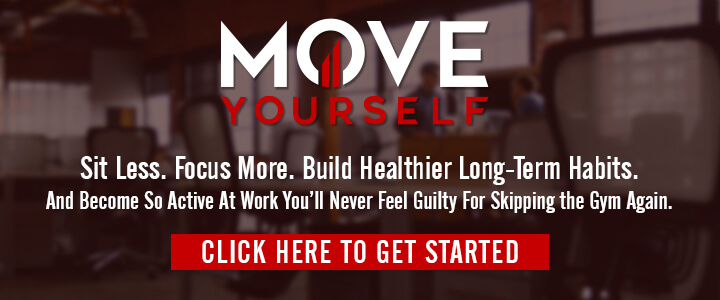Here’s the hard truth: The probability is over 70%1 that you are sitting as you read this blog post. You were probably sitting for the 60 minutes before reading this blog post, and you will probably sit for the vast majority of your day after reading this blog post. (Full disclaimer: I’m also sitting as I write this blog post)
You sit to eat breakfast. You sit in your car on the way to work. You sit in front of your workstation all day (and night). Then you sit in front of Netflix for three more hours trying to slow down your racing thoughts knowing you probably should’ve gone to the gym to offset how sedentary you were all day.
And the worst part is, you probably already know that sitting is killing you.
Or is it?
‘SEDENTARY’ IS THE NEW SMOKING, NOT SITTING
If you have a working internet connection, you’ve most likely come across the headline ‘Sitting Is the New Smoking.’ This sensationalist phrase, as coined by Dr. James Levine, director of the Mayo Clinic at Arizona State University, is everywhere. Countless studies have correlated chronic sitting with an increased risk for type 2 diabetes and cardiovascular disease2, breast cancer3 and kidney disease in women4, colon cancer in men5, numerous chronic issues related to obesity, and oh yeah…death6.
But like a frog slowly boiling in water, you don’t realize anything is wrong until it’s too late.
According to Dr. Levine:
“Sitting is more dangerous than smoking, kills more people than HIV and is more treacherous than parachuting. We are sitting ourselves to death.”
What’s alarming to me about all of these studies as they relate to those of us who work in creative fields is they warn people of the negative and deadly consequences of sitting up to 6-8 hours per day.
Seriously? 6-8 hours?
6-8 hours is a half day for most creative professionals.
As I’ve done more and more outreach to the creative community, what I’ve learned is the knee-jerk reaction to sitting all day long is to start standing. Legendary film editor Walter Murch inspired me to start standing almost ten years ago, and at the time I was considered an outcast. A lot has changed since then. For example, during my first season editing the television show Empire, almost every workstation was a standing workstation, and they are becoming commonplace throughout the filmmaking industry now.
A revolution is underway where companies are (finally) embracing the idea that standing workstations can promote higher levels of focus and productivity. But there is a lot more to staying healthy at work than simply getting a standing workstation and calling it a day.
WHY YOUR STANDING DESK ISN’T CUTTING IT
In my podcast interview with Ben Greenfield, one of the world’s foremost health & fitness experts, we discuss in detail what is happening to your body at the physiological level when you sit for long periods during the day and why sitting can lead to all of the aforementioned health risks. But more importantly we also discuss why there is nothing inherently wrong with sitting. Placing your body in a seated position is not doing any serious damage in and of itself, the serious damage comes when your body is chronically in the same position with little or no movement for 60-90 minutes or more at a time.
The negative health consequences of being sedentary for more than 60-90 minutes apply to any position…including standing.
Click here to learn everything that science knows about standing desks
In short, if you are standing all day:
- You are going to burn more calories.
- You will most likely increase your HDL cholesterol (aka the ‘good’ cholesterol).
- You may lose a little weight.
- You’ll probably be in a better mood.
- And even cooler, standing has an anti-aging benefit.
And while there isn’t a ton of scientific research to back this up, I will argue that you are more creatively engaged with your project and can maintain focus for longer periods of time. As Walter Murch said in our podcast together, being a film editor (like many other highly creative professions) is a combination of being a surgeon, an orchestra conductor, and a short order cook…all of whom stand while working.



Don’t get me wrong, a standing workstation is a great start. But don’t pat yourself on the back thinking you’ve solved all of your health problems just because you’re standing all day.
Unfortunately, standing for 12 hours in front of your workstation will only make you marginally healthier in the long run because you are still sedentary. In fact, some have even gone so far as to claim that standing desks are mostly bullshit. What I’ve found from years of personal experience is that if you stand to avoid the chronic pain associated with sitting, you are only shifting the pain to different places in the body, especially if you don’t know how to make the transition correctly. Ask any orthopedist or chiropractor (don’t worry, you don’t have to, I already have), they’ll tell you the standing desk movement hasn’t lessened their number of regular clients, it’s just changed the problems they have.
So I guess that means finding more hours in the day to exercise, right? Not so fast…
WHY EVEN EXERCISING ISN’T ENOUGH
Here’s where it gets really frustrating. Even if you have miraculously found an extra hour before or after work to jog, bike, or even throw in some HIIT training, you still aren’t offsetting the negative effects of being sedentary for the vast majority of your day7. Don’t get me wrong, exercise is fantastic for you and you should be doing it, but you can’t use the excuse that it’s okay to sit for 12 hours because you exercised. According to biomechanist Katy Bowman, author of the fantastic book Move Your DNA, you may actually be increasing your risk for cardiac issues by sitting all day and then jamming in a workout at night. By sitting all day you are restricting blood flow and circulation through your blood vessels, and when you suddenly try to pump enormous amounts of blood through these vessels very quickly, it’s like trying to run water through a kinked hose. You may end up doing more harm than good.
To put into perspective how difficult it is to use exercise to counteract the effects of sitting and/or being sedentary, recent research has shown that it requires at least an hour of intense exercise to offset the negative effects of sitting for 6-7 hours per day8.
If you are regularly working a 12 hour shift like many creative professionals, you would need to exercise for almost 2 hours per day to reverse your risk of cancer, diabetes, heart disease, and obesity.
Do you have two hours per day to exercise on top of a 12 hour shift with no lunch break? Me neither.
THE ANSWER IS CONSISTENT MOVEMENT
It has taken me ten years of intense personal research and experimentation to come to this realization, but the key to better health if you live in front of your workstation like me is not a standing desk, a ball chair (which is actually worse for you than a regular chair), or hitting the gym at 5 am before a 14 hour shift.
The key to better health at your sedentary job is constant movement throughout the day.
With our schedules it is just not realistic to find dedicated time to exercise on a regular basis, and even if we did find that time, we’re either sacrificing sleep in the morning or we’re too exhausted at night to even think about going to the gym, getting on a treadmill, or doing a round of P90X.
Knowing that activity is the key to staying healthy has lifted a huge weight off my shoulders and has taken the guilt away of never having the time to exercise. According to this study:
“Simply reducing inactivity by increasing the time spent walking or standing is a more effective way to help reduce certain health risks than one hour of physical exercise.”
Rather than thinking the only answer to getting healthy is the “all or nothing” approach, i.e. starting (then quitting) an intense diet & exercise program, try taking one baby step at a time.
Here are five simple ‘Easy Wins’ to be more active at work with little to no extra effort:
- Park your car as far away as possible in the morning (or if possible, walk to work)
- Take the stairs instead of the elevator
- Ditch phone, email, and IM’s, and actually walk to speak to your colleagues in the office
- Walk during phone calls (I’ve gotten 7500+ steps on a single call)
- Step away from your workstation every hour and take a 5 minute activity break
NEVER FEEL GUILTY FOR SKIPPING THE GYM AGAIN
What I have found is that no matter how busy my schedule, I am able to get in plenty of moderate activity throughout the day, so much so that I have found myself having as much as 15,000 steps at the end of a busy day, and if someone asked me what I had done, I would’ve said, “Nothing really, I was just working.”
Here are my Fitbit stats after a typical 16 hour day (with no exercise and no treadmill desk)
I am able to get these kinds of stats because I have shifted my mindset, redesigned my work environment to make it more ‘dynamic,’ and created healthier long-term habits so that staying active becomes an afterthought – a mindless activity that doesn’t require willpower or conscious decisions that require energy and time. Having learned a tremendous amount about human psychology and how habits drive our lives, I have essentially turned myself into Pavlov’s dog when it comes to being active in front of my workstation, no matter how crazy my day.
Here’s the cool part: Being active while still getting the job done (faster) is much easier than you think.
I would love to help you sit less, focus more, build healthier long-term habits, and become so active at work that you’ll never feel guilty for skipping another day at the gym again. Click below to learn more about getting started with my brand new ‘Move Yourself’ online learning program.



